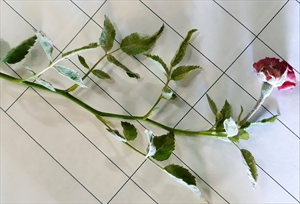- Worldwide distribution. In Oceania, Australia, New Caledonia, New Zealand, Tonga. A disease of rose.
- Damage: white powdery growth (masses of spores) over surface of leaves, stems and flowers, causing distortions, leaf curling, and unsightliness of the flowers affecting appearance and economic value.
- Spread: spores in wind. Note, free water not needed for germination and infection. Survival unusual - fungal mycelium survives in the bud.
- Cultural control: in the nursery - check plants for infection; in the field/garden choose sunny, well-drained site, and space to allow good air circulation; water frequently, early morning, avoiding overhead irrigation; prune infected leaves, flowers; avoid over-fertilization; weed; resistant varieties.
- Chemical control: minerals (i) sulphur, copper, sodium (or potassium) bicarbonate; botanicals (ii) neem, garlic, rosemary, thyme, clove oils, vinegar; synthetics (iii) protectant fungicides - mancozeb or systemic fungicides - triazole or strobilurin. Milk can also be used.





